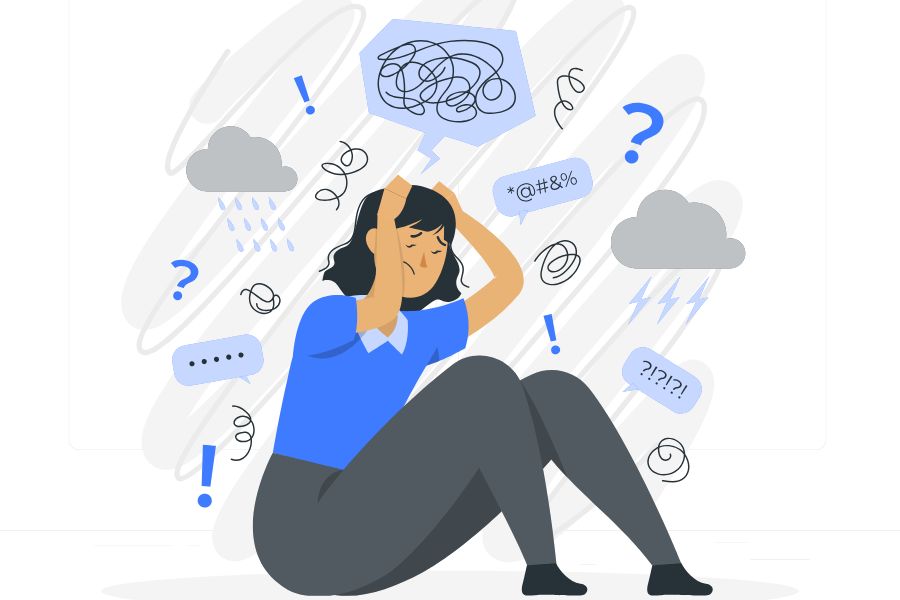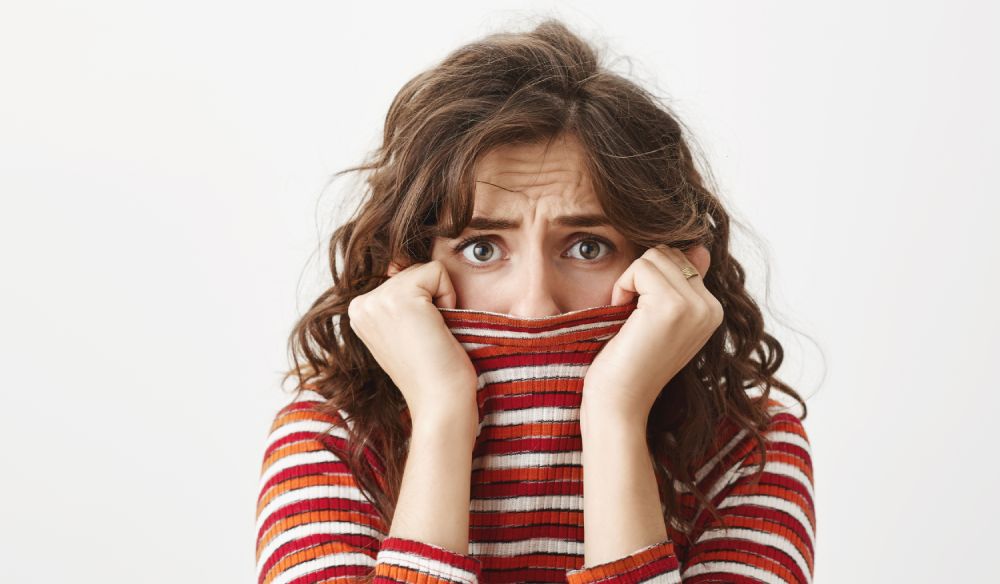When we hear the word “Anxiety”, we think about the worst case scenario. But today due to an increase in the awareness around us, we are quite familiar with this emotion and this term.
Anxiety is the body’s natural response to stress. It’s a feeling of fear or apprehension about what’s to come. Having said that, it is but natural that each one of us has felt anxious at some point in our lives. But we see people using the term “I have anxiety” casually in the conversations.
Feeling anxious, for example, going to a job interview or giving a speech on the first day of school may cause some people to feel fearful and nervous, is different from having an anxiety disorder.
In this blog we’ll discuss a few points on the following lines
- What exactly is Anxiety
- Anxiety disorders
- Signs
- Types of Anxiety and Anxiety disorders
- Therapies that are used
- Coping strategies one can use in day to day life.
What is Anxiety ?
- Anxiety is an emotion characterized by feelings of tension, worried thoughts, and physical changes like increased blood pressure.
- People with anxiety disorders usually have recurring intrusive thoughts or concerns. They may avoid certain situations out of worry. They may also have physical symptoms such as sweating, trembling, dizziness, or a rapid heartbeat.
- Anxiety is not the same as fear, but they are often used interchangeably. Anxiety is considered a future-oriented, long-acting response broadly focused on a diffuse threat, whereas fear is an appropriate, present-oriented, and short-lived response to a clearly identifiable and specific threat.
Anxiety may be defined as apprehension, tension, or uneasiness that stems from the anticipation of danger, which may be internal or external (Diagnostic and Statistical Manual of Mental Disorders, 1980)

Types of Anxiety
In 1966, Spielberger suggested that conceptual anxiety could be introduced to multifaceted definitions of anxiety by distinguishing trait anxiety from state anxiety. Spielberger defined trait anxiety as an individual’s predisposition to respond, and state anxiety as a transitory emotion characterized by physiological arousal and consciously perceived feelings of apprehension, dread, and tension.
State Anxiety is state specific. It is localized and related to specific fears for eg – stage fear.
Seperation anxiety disorder, selective mutism, specific phobia, social anxiety are the disorders which come under the State anxiety type
Trait Anxiety as the name suggests, is a part of the trait or the personality itself. People with trait type to anxiety carry it everywhere with them. Panic disorder, Generalized Anxiety Disorder come under the Trait anxiety type.
Type of Anxiety Disorders
What are the major types of anxiety disorders?
There are several types of anxiety or anxiety disorders. Here are some of the more common types according to the National Institute of Mental Health
Generalized anxiety disorder (GAD)
The essential feature of generalized anxiety disorder is excessive anxiety and worry/ anticipation about a number of events or activities. The intensity, duration or frequency of the anxiety and worry is out of proportion to the actual likelihood or impact of the anticipated event. The individual finds it difficult to control the worry and to keep worrisome thoughts from interfering with the day to day life. (DSM V)
Obsessive-compulsive disorder (OCD)
A person with OCD has thoughts that are difficult to control. They may find themselves repeating actions over and over. Obsession are repetitive and persistent thoughts, images or urges that are intrusive and unwanted and may cause distress.
Whereas compulsions are repetitive behaviours that the individual feels driven to perform in response to an obsession. (DSMV)
Panic disorder
Panic disorder refers to recurrent unexpected panic attacks . A panic attack is an abrupt surge of intense fear or intense discomfort that reaches a peak within minutes,
and during which physical and cognitive symptoms such as heavy breathing, sweating, increased palpitations occur. (DSM V)
Post-traumatic stress disorder (PTSD)
The essential feature of posttraumatic stress disorder (PTSD) is the development of characteristic symptoms following exposure to one or more traumatic events.
The clinical presentation of PTSD varies. In some individuals, fear-based reexperiencing, emotional, and behavioral symptoms may predominate. In others, anhedonic (loss of interest) or dysphoric( unhappy) mood states and negative cognitions may be most distressing. (DSM V)
Social anxiety disorder (social phobia)
The essential feature of social anxiety disorder is a marked, or intense, fear or anxiety of social situations in which the individual may be scrutinized by others. In children the fear or anxiety must occur in peer settings and not just during interactions with adults. When exposed to such social situations, the individual fears that he or she will be negatively evaluated. The individual is concerned that he or she will be judged as anxious, weak, crazy, stupid, boring, intimidating, dirty, or unlikable. The individual fears that he or she will act or appear in a certain way or show anxiety symptoms, such as blushing, trembling, sweating, stumbling over one’s words, or staring, that will be negatively evaluated by others. Some individuals fear offending others or being rejected as a result. Fear of offending others—for example, by a gaze or by showing anxiety symptoms—may be the predominant fear in individuals.(DSM V)
Phobias
A key feature of this disorder is that the fear or anxiety is due to the presence of a particular situation or object. The categories of feared situations or objects are provided as specifiers. Many individuals fear objects or situations from more than one category, or phobic stimulus. For the diagnosis of specific phobia, the response must differ from normal, transient fears that commonly occur in the population.
The amount of fear experienced may vary with proximity to the feared object or situation and may occur in anticipation of or in the actual presence of the object or situation. Also, the fear or anxiety may take the form panic attack Another characteristic of specific phobias is that fear or anxiety is evoked nearly every time the
individual comes into contact with the feared object/situation.(DSMV)
Separation anxiety disorder
Separation anxiety disorder is most commonly diagnosed in kids, especially young children. However, adults can also experience this type of anxiety if they have extreme fear about something bad happening to a person in their life.
In children, the symptoms of fear, panic, worry, and anxiety surface when they’re separated from a parent or loved one.
Adults may have extreme fear and worry about something tragic happening to a family member or loved one, even when they’re together. (DSM V)
Agoraphobia
The essential feature of agoraphobia is marked, or intense, fear or anxiety triggered by the real or anticipated exposure to a wide range of situations.
When experiencing fear and anxiety cued by such situations, individuals typically experience thoughts that something terrible might happen. Individuals frequently believe that escape from such situations might be difficult (DSM V)
Signs and Symptoms
Anxiety can trigger symptoms like
- excessive fear and worrying
- Restlessness
- agitation
- panic
- irritability
- irrational fear of danger
- racing thoughts
- shortness of breath or rapid breathing
- sleep issues
- headache and stomachache
- pounding heart
- insomnia
- trembling
- muscle tension
Psychological Therapies Used for Anxiety
Mental health professionals have several types of psychotherapy to choose from, but some are better suited for specific issues like anxiety.
While each professional uses their own treatment methods, here are some that are recommended to treat anxiety:
- Cognitive behavioral therapy (CBT)
- Exposure therapy
- Acceptance and commitment therapy
- Mindfulness-based therapy
- Psychodynamic therapy
- Interpersonal therapy
Expressive art therapy is also an effective method that helps in reducing the feeling of anxiety by redirecting the attention away from worrying.

Some Helpful Coping Strategies
Learn about your mental health concerns. The more you know, the better prepared you will be to manage symptoms and roadblocks along the way. Don’t be afraid to ask your doctor any questions you might have. Remember, you are a key part of your health care team.
Stick to your treatment plan.If you are on medication to manage anxiety, it is advisable to adhere to the medication as per the mental health professional’s advice. Suddenly stopping medication without professional advice may result into worsening of symptoms.
Cut down on foods and drinks that have caffeine, such as coffee, tea, cola, energy drinks, and chocolate. Caffeine is a mood-altering drug, and it may make symptoms of anxiety disorders worse.
Avoid use of alcohol and recreational drugs. Substance abuse can increase the features of anxiety.
Eat right and exercise. Brisk aerobic exercises like jogging and biking help release brain chemicals that reduce stress and improve your mood.Get better sleep. Sleep problems and anxiety disorder often go hand in hand. Make getting good rest a priority. Follow a relaxing
bedtime routine. Talk to your doctor if you still have trouble sleeping.
Practice relaxation techniques. Stress management is an important part of your anxiety disorder treatment plan. Things like meditation, or mindfulness, can help you unwind after a stressful day and may make your treatment work better.
Keep a journal. Writing down your thoughts before the day is down may help you relax so you’re not tossing and turning with anxious thoughts all night.
Manage your negative thoughts. Learn to restructure your self defeating thoughts into those that are more rational and adaptive in nature to reduce anxiety. This can be challenging if you have certain types of anxiety, however. Cognitive behavioral therapy can teach you how to redirect your thoughts.
Get together with friends. Whether it’s in person, on the phone, or the computer, social connections help people thrive and stay healthy. People who have a close group of friends that support and chat with them have lower levels of social anxiety.
Seek support. Some people find it helpful and uplifting to talk to others who are experiencing the same symptoms and emotions. Self-help or support groups let you share your concerns and achievements with others who are or who have been there. It’s better to arrange personalized support from the best counselors in india.
So, here’s the in depth understanding of what anxiety disorder is and how serious it could get. But, at the same time it can be
controlled if we are aware of the signs and symptoms and use whatever coping strategies we can on our level.
Being aware of this disorder would also mean not to use the term “i have anxiety” casually in a conversation. Instead, understand the difference between “i feel anxious” and “i have anxiety disorder” and be conscious of what we say.
References
Adapted from the Encyclopedia of Psychology and APA Dictionary of Psychology
(Diagnostic and Statistical Manual of Mental Disorders, 1980)
Diagnostic and Statistical Manual of Mental Disorders, 5th edition (DSM-5)
Kirkwood, C. K., & Melton, S. T. (2002). Anxiety disorders. In J. T. Dipiro, R. L.
Talbert, G. C. Yee, G. R. Matzke, B. G. Wells, L. M. Posey, Pharmacotherapy: A pathophysiologic approach (5th ed.). New York, NY: McGraw-Hill.
Cates, M., Wells, B. G., & Thatcher, G. W. (1996). Anxiety Disorders. In E. T. Herfindal and D. R. Gourley (Eds.).
Textbook of Therapeutics: Drug and Disease Management (6th ed., pp. 1073-1093). Hagerstown, MD: Lippincott Williams and Wilkins.
Pies, R. W. (1994).
Clinical manual of psychiatric diagnoses and treatment: a
biopsychosocial approach Washington, DC: American Psychiatric Press.

